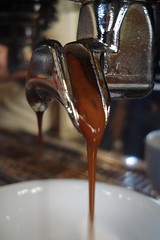Last Sunday, I entered what some among us may consider the final frontier, and I took eight other people with me.
We cupped…
…a Starbucks coffee.
I was leading a class about the ways roast levels can affect a coffee's natural (and more or less regional, just for the sake of simplification) flavor profile. On limited time, a limited budget and limited resources, I scouted three Ethiopian coffees, keeping in mind that this class (which was aimed at people who have never cupped a coffee or who are perhaps relatively new to thinking of coffee in a culinary or palate-centric way) was not in an way meant to be a "comparison" of the "good" or "bad" qualities in the coffees on the table.
First of all, I love Ethiopian coffees—they are probably, regionally speaking, my favorites, more or less across the board. I like to think of them as afternoon coffees, the kind you enjoy while sitting on the couch on a Sunday at 3pm, your back propped up against two soft pillows, your nose in a great book. I get really excited about them, and I get really excited by the different ways they take to roast.
When the class was conceived, I knew right away that we would simply have to enter Starbucks territory, since they get such a bad rap on the darkness tip. Because the packaging on their coffee says nothing about the roast level (or date, for that matter, other than the somewhat disheartening stamp of "Use by March 2008") except for the somewhat misleading adjective, "Bold," I told everyone in the class to approach it with an open mind.
It sat there on the cupping table, looking up at us from its position among Counter Culture Coffee's Biloya , (purchased at Ninth Street Espresso), and Novo Coffee Roasters' Beloya Selection One, (purchased at Café Grumpy), and the Starbucks was clearly much darker. A more seasoned professional could probably tell you the degree of roast by looking at it, but I, in my limited exposure, could not. Perhaps a shade or two past Vienna? I don't know. Fascinating.
Second of all, exactly two of the eight students standing before me had ever had an Ethiopian coffee before, or even had really ever given thought to the complexities of the bean, its growth or its preparation in the roaster—so we had a wee (and I mean wee) lesson about the spectrum.
"So what do you think all of this means in terms of flavor?" I asked my class.
[Crickets]
"Okay then, let's try them!" And we dug in.
People with very little coffee experience are often the most interesting to have take part in something like this, because you can get really honest opinions and reactions from them. Here are some of our collective cupping notes, which were great (though we were all feeling a little shy):
Counter Culture's Biloya (natural sundried—Biloya, Ethiopia)
Aroma: unmistakable dark, tart berries; fresh nutmeg or cinnamon.
Fragrance: tomatoes and grapefriut at first, then curries or birch bark.Brightness: (I find this to be the hardest quality to explain to people new to cupping. Often, if they are really struggling with it, I'll tell them not to worry, that it will come with time and experience.)
Flavor: mentions of cherries, baked tarts, cinnamon; "It's the tartest of the three, in a really nice way"; some woodsy, savory notes, but very subtle.
Body: "Like wine."
Aftertaste: "Almost none at all. It melts in your mouth."
The Counter Culture was the group's overall favorite. "It's so clean!" exclaimed one woman. "I could drink the whole sample," said another.
Novo Coffee's Beloya Selection One (Sidamo, Ethiopia)
Aroma: blueberries, blueberries, blueberries. oh, and vanilla.
Fragrance: rather intense lemon.
Flavor: very mild and bright, still strong blueberry tones, and some "corn or some other sweet vegetable."
Body: like herbal tea—barely there. (I thought it was a bit like the weight of lemonade or salt water—very pleasantly so)
Aftertaste: none or very little.
This was the subtlest—and lightest—of the three. Its mouthfeel and sweet finish really rounded out the cup. The citrus really popped as the sample cooled, too.
Starbucks' Ethiopian Sidamo ("Bold")
Aroma: salt, tobacco, cloves, "dirt."
Fragrance: mud, black pepper, "coffee."
Flavor: "really minty," which I think was my favorite. I could totally see where she would get that! wild.
Body: heavier than the other two, by far; a bit more of a bite in the cheeks as it left your mouth.
Aftertaste: the longest linger of the three.
One woman whole-heartedly preferred this one, saying that it kind of blew the others out of the water for her. I told her that's fine: "You're cultivating preferences; that is really important. If you learn more about what you like, you will be less frequently disappointed by expensive bags of 'gourmet' coffee that sit unused and stale in your kitchen!" That's part of the point of this class and, I like to think, any other I might teach: finding out what we like and understanding why.
I actually thought the 'bucks beans held up pretty well under the gun, considering the fact that, uh, who knows when they were roasted! I'm not by any stretch a Starbucks hater, but I really didn't think it would be as pleasant and interesting an experience as it turned out to be. I don't dislike their coffees in general, but I do normally favor stuff on which a lighter hand was taken.
Have any of you ever cupped an SB product, especially in comparison with a microroast or a more-strictly-speaking specialty coffee? I'm really curious!
(Thanks for inspiring me to post, Chris Owens! Hope this one doesn't disappoint…)
12/20/07
Cups and bucks
Posted by
Meister
at
2:52 PM
![]()

